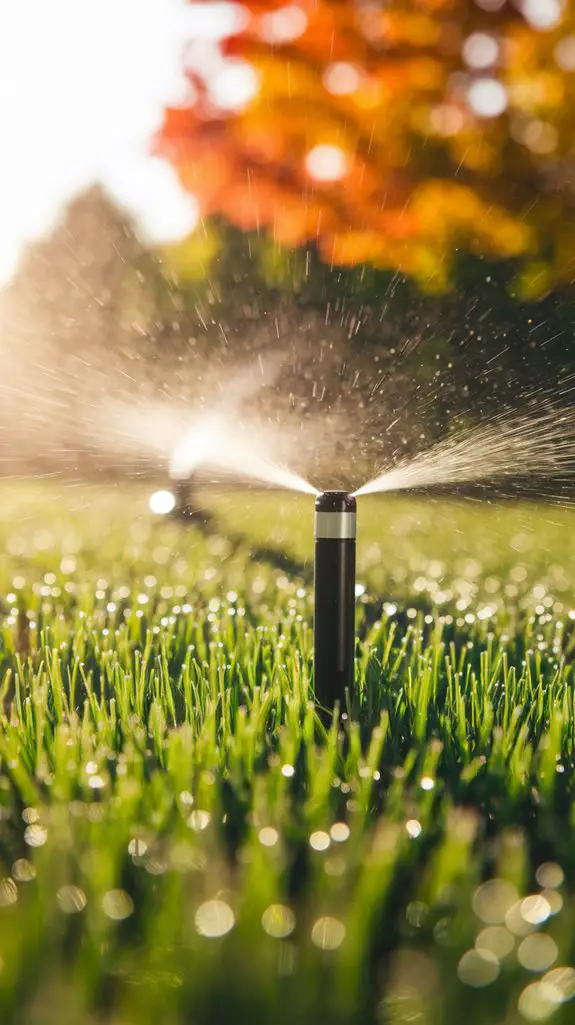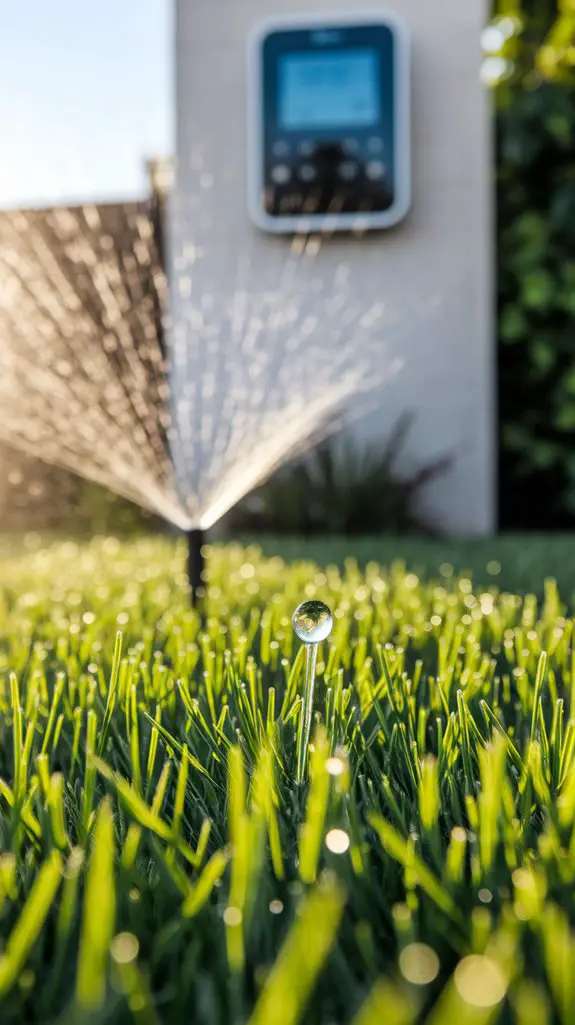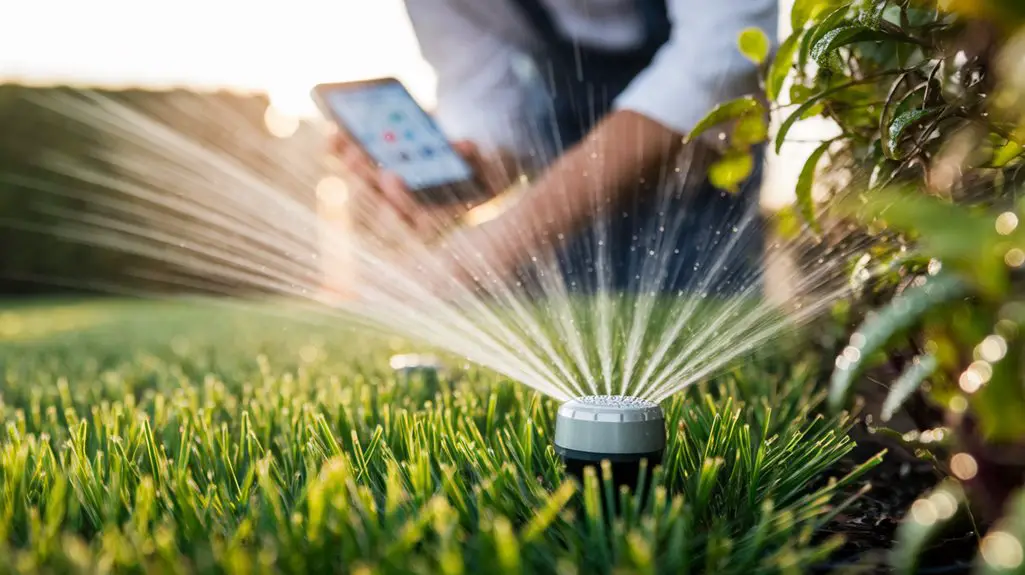You’re spending too much water and money on your lawn care. In most regions, outdoor irrigation accounts for 30-60% of residential water use—with up to half being wasted through inefficient practices. By implementing smarter irrigation techniques, you’ll not only conserve a precious resource but also maintain a healthier lawn with deeper roots. The right watering approach can dramatically reduce your water bills while producing more vibrant turf that’s naturally resistant to drought, disease, and pests.
Water Your Lawn at the Optimal Time
When should you water your lawn for maximum efficiency? Early morning—specifically between 4:00 AM and 10:00 AM—provides ideal conditions. During these hours, water pressure is typically stronger, evaporation rates are lower, and wind speeds are minimal, ensuring water reaches root zones rather than evaporating.
Avoid evening watering despite reduced evaporation, as prolonged leaf moisture creates perfect conditions for fungal diseases.
Midday irrigation wastes water through evaporation—up to 30% can be lost before reaching roots.
Water deeply but infrequently—1 to 1.5 inches per session, allowing soil to partially dry between waterings. This encourages roots to grow deeper, increasing drought tolerance. Incorporating drought-resistant landscaping techniques can further enhance your lawn’s resilience.
Use a rain gauge or moisture meter to measure precisely and adjust your irrigation controller seasonally for maximum water conservation.
Adjust Irrigation Based on Seasonal Needs

As seasons change throughout the year, your lawn’s water requirements fluctuate considerably based on temperature, precipitation, and growth patterns. You’ll need to adjust your irrigation controller accordingly to prevent waste while maintaining turf health.
| Season | Water Needs | Schedule Adjustment |
|---|---|---|
| Spring | Moderate | 2-3 days/week |
| Summer | High | 3-4 days/week |
| Fall | Decreasing | 1-2 days/week |
During summer’s peak heat, your lawn may require up to 1.5 inches of water weekly. Reduce this by 30% in spring and 50% in fall. In winter, many cool-season grasses go dormant, requiring minimal supplemental irrigation—perhaps once every 2-3 weeks if rainfall is insufficient. Use a rain sensor to automatically skip scheduled cycles during wet periods. Additionally, implementing eco-friendly practices can enhance the overall health of your lawn while conserving water.
Install Smart Controllers for Automatic Adjustments

Smart irrigation controllers represent the pinnacle of modern lawn-care technology, eliminating guesswork and manual adjustments through automated systems.
These devices connect to local weather stations or use on-site sensors to monitor rainfall, temperature, humidity, and soil moisture in real-time.
You’ll find two primary controller types on the market: weather-based systems that adjust watering schedules according to local meteorological data, and soil moisture sensors that trigger irrigation only when your lawn needs it.
Installation typically involves replacing your existing timer with the smart controller and connecting to your home’s Wi-Fi network.
Many models offer smartphone apps that provide detailed water usage reports and allow you to make adjustments remotely.
Studies show smart controllers can reduce water consumption by 20-50% while maintaining healthier turf through precise hydration cycles.
Group Plants With Similar Water Requirements
Creating zones with plants that share similar hydration needs forms the foundation of water-efficient landscape design. This practice, known as hydrozoning, prevents both overwatering and underwatering by delivering precisely what each plant group requires.
Assess your landscape and categorize plants into high, medium, and low water-use zones. Place thirsty perennials and annuals together, while grouping drought-tolerant natives and succulents in separate areas.
When planting, position high-water plants in naturally moist areas like depressions or shaded spots. You’ll need to adjust your irrigation system accordingly—installing separate valves and controllers for each zone.
This targeted approach allows you to water each zone differently based on specific requirements. Additionally, incorporating natural pest control methods can further enhance the health and resilience of your garden. The result? You’ll conserve water, reduce runoff, minimize disease, and create a landscape that thrives with ideal hydration.
Use Drip Irrigation for Targeted Watering
Drip irrigation represents one of the most efficient watering methods available for residential landscapes, delivering water directly to plant root zones where it’s needed most. This system reduces water loss from evaporation, runoff, and wind drift by up to 60% compared to traditional sprinklers.
You’ll find installation relatively straightforward—connect microtubing to your main water line and position emitters near plant bases. Set flow rates between 0.5-4 gallons per hour depending on soil composition and plant needs. For clay soils, use lower rates to prevent pooling; sandy soils require higher rates.
Program your system to operate during early morning hours (4-7am) when evaporation rates are lowest. Check emitters monthly for clogs and install a pressure regulator to extend system life and guarantee consistent water delivery.
Perform Regular System Maintenance Checks
Regular maintenance of your irrigation system guarantees peak performance while preventing costly water waste throughout the season.
Inspect all sprinkler heads monthly for clogs, misalignment, or damage. Clean filters and nozzles quarterly to guarantee consistent water flow and pressure.
Check for leaks by running a pressure test at the beginning of each watering season. You’ll need to examine all connections, valves, and pipes for cracks or corrosion.
Replace worn washers and damaged components immediately.
Adjust sprinkler heads seasonally as plant growth can obstruct spray patterns.
Don’t forget to winterize your system before the first freeze by shutting off the water supply and blowing out remaining water from lines. This prevents pipe ruptures and costly repairs.
Maintain a maintenance log to track repairs and establish an efficient schedule for ongoing inspections. Additionally, simple lawn care tips can help ensure that your lawn remains healthy throughout the season.
Collect Rainwater to Supplement Irrigation
While municipal water supplies can be costly and environmentally taxing, harvesting rainwater offers an eco-friendly alternative that can considerably reduce your irrigation expenses.
Install rain barrels or cisterns beneath downspouts to capture runoff from your roof. A typical 1,000-square-foot roof can collect approximately 600 gallons from one inch of rainfall.
Connect your collection system to drip irrigation lines or soaker hoses for efficient distribution. Consider adding a small pump if gravity flow is insufficient.
Filter collected water to prevent clogging irrigation components. Position barrels on elevated platforms to increase water pressure and improve flow.
During drought restrictions, your stored rainwater becomes a valuable resource exempt from usage limitations. Additionally, rainwater collection barrels can be easily integrated into your existing landscape design to enhance aesthetics while promoting sustainability.
Implementing this sustainable approach not only conserves water but also reduces stormwater runoff that can carry pollutants to local waterways.
Apply Mulch to Retain Soil Moisture
Applying a 2-3 inch layer of organic mulch around plants serves as one of the most effective moisture retention strategies in lawn care. This protective barrier greatly reduces evaporation rates, allowing you to decrease watering frequency by up to 30%.
Select mulch materials like wood chips, shredded bark, or compost for best results. Apply mulch in a donut formation, keeping it 2-3 inches away from plant stems and tree trunks to prevent rot and pest infestation.
For newly established lawn sections, apply a thin layer of compost as mulch to protect emerging grass shoots.
You’ll need to replenish your mulch annually as organic materials decompose. The decomposition process provides an added benefit—it introduces valuable nutrients into your soil while improving its structure and water-holding capacity.
Test Your Soil to Determine Water Needs
Understanding your soil’s composition provides the foundation for effective irrigation decisions.
Clay soils retain moisture longer but absorb water slowly, while sandy soils drain quickly but require more frequent watering. Purchase a soil testing kit to determine your soil’s pH and texture, or send samples to your local extension office for thorough analysis.
You’ll need to adjust your irrigation schedule based on these results. For clay soils, water less frequently but for longer durations to prevent runoff. For sandy soils, implement shorter, more frequent irrigation cycles.
Also test for organic matter content—soils with higher organic matter retain moisture better and require less frequent watering. Knowing your soil’s specific infiltration rate allows you to program your irrigation system precisely, preventing both water waste and drought stress.
Monitor and Measure Water Output for Efficiency
To guarantee ideal water distribution throughout your landscape, you’ll need to regularly monitor and measure your irrigation system’s actual output.
Place catch cups or rain gauges at various points within each irrigation zone and run your system for a fixed time interval—typically 15 minutes—to quantify water delivery.
Aim for uniformity coefficients above 70% across all zones. If you notice significant disparities, check for clogged nozzles, misaligned heads, or pressure inconsistencies.
Monthly flow meter readings can also identify potential leaks, as unexpected increases often indicate underground ruptures.
Modern smart controllers allow you to adjust run times based on measured output and seasonal evapotranspiration rates.
Document your readings in a water log to track efficiency improvements over time and identify when components need maintenance or replacement.
Conclusion
By implementing these targeted irrigation strategies, you’re ensuring your lawn thrives while conserving water. The evidence supports the theory that precision watering techniques reduce consumption by 30-50% compared to conventional methods. You’ll notice improved root development and disease resistance when you’re delivering water exactly where and when it’s needed. Check your system routinely—even minor adjustments can greatly impact both your lawn’s health and water conservation efforts.




